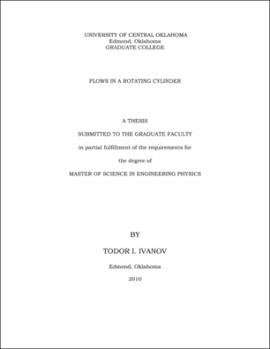| dc.contributor.advisor | Martin, David | |
| dc.contributor.author | Ivanov, Todor I. | |
| dc.date.accessioned | 2020-05-26T20:34:32Z | |
| dc.date.available | 2020-05-26T20:34:32Z | |
| dc.date.issued | 2010 | |
| dc.identifier.other | (AlmaMMSId)9974615185202196 | |
| dc.identifier.uri | https://hdl.handle.net/11244/324627 | |
| dc.description.abstract | The purpose of this work is to focus on studying Görtler vortices inside a rotating cylinder. The literature review chapter, (Chapter 1), gives us insight from Görtler and Hämmerlin on the dominant - centrifugal and viscous forces. Their theoretical work inspired the hypothesis of this paper that for a fixed volume-fill, and diameter cylinder, there is a discrete set of tangential speeds of rotation when the Görtler vortices become axially stable. Or, equivalently, that the down-wash regions of the vortices do not move along the z-axes. In the Findings chapter we will discuss what we have discovered on how the coriolis effects shape the flow front for a cylinder with a low fill-volume fraction. The gravitational effects from the suspended over the boundary layer pool can not be ignored for cylinder fill-volumes of 7/10, 8/10 and 9/10 fill. The axial end effects are linked to the existence of a Gibbs phenomenon in a whole section in Chapter 3. Two flow phenomena are described in the literature: (1) Hygrocysts- sheets of water that form along the z-axes [2] (2) "Shark teeth"- for a low fill volume fraction, the flow front takes on periodically varying in axial direction angular values. [14] We will link the above two flow phenomena to a common underlying cause: the Görtler vortices. The first resulting from strong vortices and the second from a coriolis force. We will introduce the hypothesis that for some values of the tangential speed of rotation the vortices stop shifting axially and become axially fixed (along the z-axis). That makes the axially unstable vortices the far more common event in the domain of tangential speeds for a finite rotating cylinder. The Literature Review (Chapter 1) answers the question if there is a lower limit on the tangential speed of rotation for the vortices first to appear. This is the main question answered by the Hämmerlin's 1955 paper. It will show that the vortices exist even for very low free stream velocity (Görtler number). The overview of Hämmerlin's breakthrough solution on the Görtler problem is covered exclusively in Chapter 1 since it is the most detailed theoretical work concerning the vortices (according to Görtler). Hämmerlin solves a system of coupled non-adjoint differential equations for the value of a common parameter. That parameter describes when the two coupled equations have a joint solution. The algorithm is by H. Wielandt from 1944 [7]. The algorithm gives the common parameter as a function of the other dimensionless number in the system, Eqs. 28, 29. The graph of the Görtler number as a function of the other dimensionless number is on Figure 9. The three curves on that figure result from different levels in the iteration algorithm. At the end Hämmerlin shows that the parameter does not take on a positive local minimum within the approximations that he used to simplify the original Navier-Stokes' equations. He also includes a section on why the parameter (Görtler number) cannot take on negative values. We then will use the air bubbles that incorporate in the water to visualize and record the action of the vortices under the surface. We will find experimentally that axially stable vortices exist for a given: cylinder curvature, tangential speed of rotation, and fill-volume fraction. There is a whole section in Chapter 3 on the gravitational effects, of the suspended pool of water over the boundary layer. This paper will link the vortices to a coriolis force that determines the shape of the flow front for low fill-volume fractions, Chapter 3. Hämmerlin's work for a flow over a concave wall is also valid for the case of an axially infinite cylinder, compare with Bottaro [16]. We will show experimentally that "Hygrocysts", or sheets of water originate from the down-wash regions. I want to thank Dr. Martin for his interest in the work and willingness to work with me. | |
| dc.rights | All rights reserved by the author, who has granted UCO Chambers Library the non-exclusive right to share this material in its online repositories. Contact UCO Chambers Library's Digital Initiatives Working Group at diwg@uco.edu for the permission policy on the use, reproduction or distribution of this material. | |
| dc.subject.lcsh | Viscous flow | |
| dc.subject.lcsh | Vortex-motion | |
| dc.subject.lcsh | Coriolis force | |
| dc.title | Flows in a rotating cylinder. | |
| dc.type | Academic theses | |
| dc.contributor.committeeMember | Wilson, Weldon | |
| dc.thesis.degree | M.S., Engineering Physics | |
| dc.identifier.oclc | (OCoLC)ocn671253464 | |
| thesis.degree.grantor | Jackson College of Graduate Studies | |
